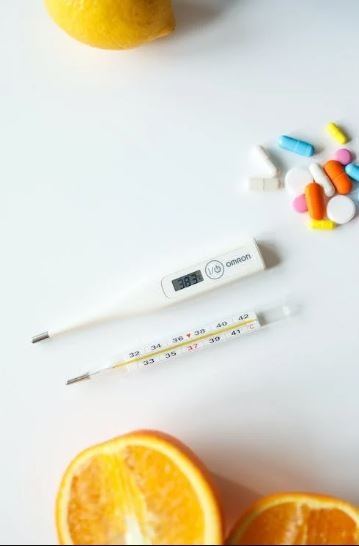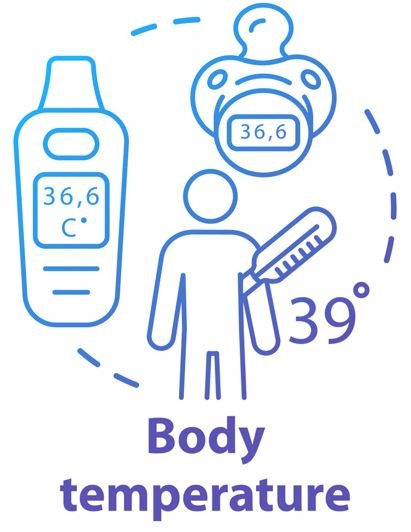Choosing a thermometer used to be simple for parents: they simply had one option! However, there are numerous types and pricing ranges to pick from on the current market. Choosing the appropriate one for your child’s age and temperament will make obtaining an accurate, simple, and rapid reading effortless.
Why should my temperature be taken?
Checking your body’s temperature with a thermometer is a simple technique to determine whether or not you have a fever. Typically, an infection will create a fever, which is a rise in body temperature. Even while fevers might be unpleasant, they indicate that the body is combating infection.
There are numerous types of thermometers available for measuring temperature. Make sure to read and adhere to the thermometer’s instructions before using any type of thermometer. If your thermometer requires batteries, verify their condition. You may observe that weak batteries produce erratic readings.
What is the average temperature of the human body?
The average body temperature is approximately 98.6 degrees Fahrenheit or 37 degrees Celsius. Normal temperature often fluctuates between 1° and 2°F (0.5° and 1°C). Normal temperatures are often lower in the morning and rise throughout the day. The peak occurs in the late afternoon or evening.
Types of Thermometer
1. Electronic thermometer
A digital thermometer is the most precise and efficient method for measuring body temperature. Digital thermometers are accessible at the majority of pharmacies and drug stores. Depending on where you shop, the price of a digital thermometer might range between $6 and $20. Follow the instructions on the packaging when using any thermometer.
2. Oral thermometer
Oral temperature can be taken with a mercury or digital thermometer. Below, we will discuss the advantages and disadvantages of mercury thermometers.
3. Digital tympanic (ear) thermometer
Utilizing infrared ray technology, tympanic thermometers determine the temperature of the ear canal.
The tympanic temperature is between 0.5°F (0.3°C) and 1°F (0.6°C) higher than the mouth temperature.
4. Temporal thermometer
Using infrared sensors, forehead thermometers assess the temperature of the superficial temporal artery, a branch of the carotid artery. Some are known as infrared thermometers without contact.
In venues like as airports, malls, and stadiums, thermometers for the forehead that do not require direct touch have become increasingly popular.
Readings taken from the forehead are around 1°F (0.6°C) cooler than those taken from the mouth.
5. Smartphone thermometer
The majority of free smartphone applications that measure temperature are built for recording the temperature of settings, not people.
Bluetooth-connected digital thermometers are utilized by temperature-taking applications for mobile devices.
6. Mercury thermometer
Once, mercury thermometers were the only option for measuring temperature. They are no longer readily accessible and may be outlawed in your area due to safety concerns.
7. Digital Pacifier thermometer
If your infant takes a pacifier, this could be a convenient way to record their approximate temperature. A pacifier thermometer comprises one or more electrical sensors within the pacifier nipple and external digital measurement and display devices. Utilizing an insulating nipple core can increase the speed and precision of sensor response. Using many sensors and digital logic to identify the highest consistent measurement helps prevent false low readings. Additionally, typical features may be added.
The Digital Pacifier Thermometer is an oral pacifier thermometer that is a good choice for infants and babies who reject a conventional thermometer. This digital thermometer has an orthodontic nipple design and provides readings every five minutes in 90 seconds.
What is a digital pacifier thermometer?
In recent years, pacifiers have become increasingly popular, with many parents depending on them to soothe their infants. However, little is known about how pacifiers affect infants’ health and how they are utilized. Utilizing a digital pacifier thermometer (Nipple) is one approach to have a deeper insight. This device measures the infant’s temperature by inserting a probe into the mouth. The thermometer is battery-operated and user-friendly, making it ideal for parents who wish to monitor their infant’s temperature without leaving the room.
How does it work?
The smart digital pacifier is an innovative and unique technique to keep your child secure and comfortable. This thermometer has a particular digital nipple that fits to the pacifier of your baby, allowing you to quickly measure their temperature. The LCD screen of the thermometer displays the temperature measurement, so you can always be certain of its accuracy.
Utilizing a Digital Pacifier Thermometer: Pros and Cons
As with many other things, the use of a digital pacifier thermometer has both positive and negative aspects.
Pros:
- Digital pacifier thermometers can test a child’s temperature without causing him or her any discomfort. This is true, particularly if your infant is accustomed to a pacifier.
- Most digital pacifier thermometers are entertaining to use since they play a tune when the temperature reading is complete.
- The vast majority of digital pacifier thermometers can store past temperature readings.
- It is safe for infant use.
- It is difficult to break.
- The product is mercury-free.
- The majority of digital pacifier thermometers have a backlight, making them simple to use at night.
Cons:
- Digital thermometers for pacifiers are not always reliable.
- Not all digital pacifier thermometer types permit disinfection of the nipple.
- When a baby is crying, digital pacifiers will be unable to take measurements.
- Some digital pacifier thermometers are more expensive than others.
- Children who are not accustomed to sucking pacifiers should not use digital pacifier thermometers.
- For the most accurate reading, your child will need to keep the pacifier in his or her mouth for three to five minutes, which can be difficult for some infants.
Advice for Use and Care
- Ensure that your thermometer is calibrated appropriately. Once you’ve established it, you should verify its accuracy every week or so. If the thermometer is not accurate, it will not provide a precise reading.
- Do not use a digital pacifier thermometer on a sleeping infant. It can be difficult to obtain an accurate reading during this period since infants frequently shift position and their temperatures fluctuate during the night.
- Do not rely entirely on the digital pacifier thermometer (nipple type) to detect whether or not your infant has a temperature.
To summarize
If your infant uses a pacifier, the digital pacifier thermometer is the most convenient method for taking his or her temperature. Your youngster only needs to suck on the pacifier until the maximum temperature is recorded. What’s amazing is that babies won’t even realize their temperatures are being taken. However, digital thermometers for pacifiers are not suggested for newborns. There are numerous varieties of contact and contactless thermometers available. The ages of your household members and your own preferences can help you decide which varieties to purchase.
As with any other household gadget, it is crucial to understand how your thermometer operates. Not all types operate in the same manner or are meant to offer identical temperature readings. When someone is unwell, the last thing you want to do is rely on conjecture.



